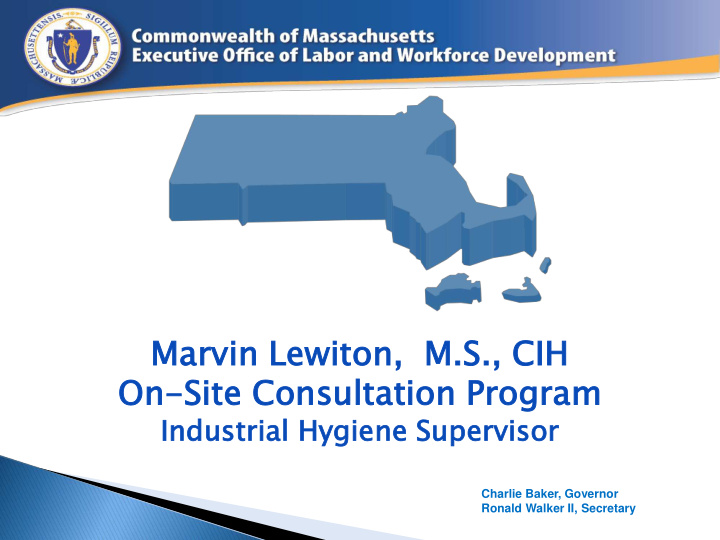



Marvin vin Lewito iton, n, M.S. S., , CI CIH On-Si On Site te Co Consultation sultation Pr Progra ogram Industr ustria ial l Hygi giene ne Su Superviso visor Charlie Baker, Governor Ronald Walker II, Secretary
United States Massachusetts Department of Department of Labor Labor Standards Occupational On-Site Safety and Health Consultation Administration (OSHA)
Consultation operates in every state Most of funding from OSHA, but separate by design 6 Safety Professionals 5 Industrial Hygienists Offices in Westborough, Lawrence, & Taunton
Free! Confidential Employers must request help Focus on small, high hazard businesses Manufacturing, construction, healthcare, food processing No penalties or fines
On-Site Surveys Technical information via phone/email Training for employers/employees Provide model safety and health programs Assist in evaluating, developing or maintaining an effective Safety and Health Program
Issue citations or fines Tell OSHA where we go, what we see, who we talk with, etc. Guarantee workplaces will “pass” an OSHA inspection
Request & schedule visit Opening conference Review of records, written programs Site walkthrough (air, noise monitoring) Closing conference Written report mailed to employer
Correct identified hazards Send abatement information Corrections by due date Extensions by written request, explain interim protection provided
Ph Physic sical l hazard rds: s: Falls Trench & excavation hazards Vehicle hazards Electrical hazards Machine guarding Chemical exposures Noise exposures
Fall Protection, residential construction (1926.501(b)(13)): 19,367 violations Ladders, portable (not 3’ above surface) (1926.1053 (b)(1)): 7,192 Fall Protection, guard rails (unprotect. edge) (1926.501(b)(1)): 6,387 Training Requirements (fall hazards, etc.) (1926.503(a)(1): 6,175 Eye and Face Protection (safety glasses) (1926.102(a)(1)): 5,835
Head Protection (Hard hats) (1926.100(a)): 4,997 Scaffolds, fall protection (ladder jacks) (1926.451(g)(1)): 3,708 Scaffolds, aerial lifts (no tie off) (1926.453(b)(2)(v)): 3,438 Fall Protection, low-slope roofs (general) (1926.501(b)(10)): 3,361 Scaffolds, access (no ladder, etc.) (1926.451(e)(1)): 2,993
Bot otto tom m line: ne: anyone exposed to a fall of six feet or more needs to be protected. Guardrails (top and midrail) Personal fall protection system Warning lines/monitor* (*ONLY for roofing on low-slope roof)
Pump jack scaffolds: Anchored at top and bottom of pole Mud sill or equivalent Top rail and midrail (net) End rails Platform overlap
Ladderjack scaffolds : Ladder base secured Platform maximum height of 20’ Platform overlap same as pump jacks NO bridging of planks Must use personal fall protection
Ladders: Bring the right size ladder Use only as manufacturer intended 3 points of contact Fiberglass for electrical Stable footing 3’ above surface Setup angle Inspection
General: Daily inspection by Comp ompeten tent t person* son* (*who has the authority to shut job down) Aerial lifts: Must be tied off in bucket or platform
Naturally occurring mineral (quartz) Stone, concrete, granite, brick, asphalt, mortar, cementitious board (Hardie Board), joint compound, etc. Exposure through cutting, grinding.
Health effects include silicosis, COPD, bronchitis, & lung cancer New OSHA Permissible Exposure Limit effective June 2017: 50 ug/m3 TWA
Requirem uirements ents fo for employe loyers rs: Written Exposure Control Plan Competent person to implement plan Housekeeping practices Medical exams Training- tasks, how to reduce exposures Recordkeeping (exposures and exams)
Respiratory protection Respiratory Protection Program ` Medical evaluation * Fit testing Training
Written program Safety Data Sheets (was MSDS) Labeling Training
Written Program: Who is responsible for Safety Data Sheets Who is responsible for labeling Inventory list of hazardous materials Who is responsible for training Who you go to with questions
Safety Data Sheets (was MSDS) Labels (GHS)
Training: What am I working with? How can it hurt me? How do I use it safely?
What’s the hazard?
Why bother?
Questions? marvin.lewiton@state.ma.us 617-626-6514
Recommend
More recommend